Growing mushrooms on tree trunks
6 years ago · Updated 6 months ago
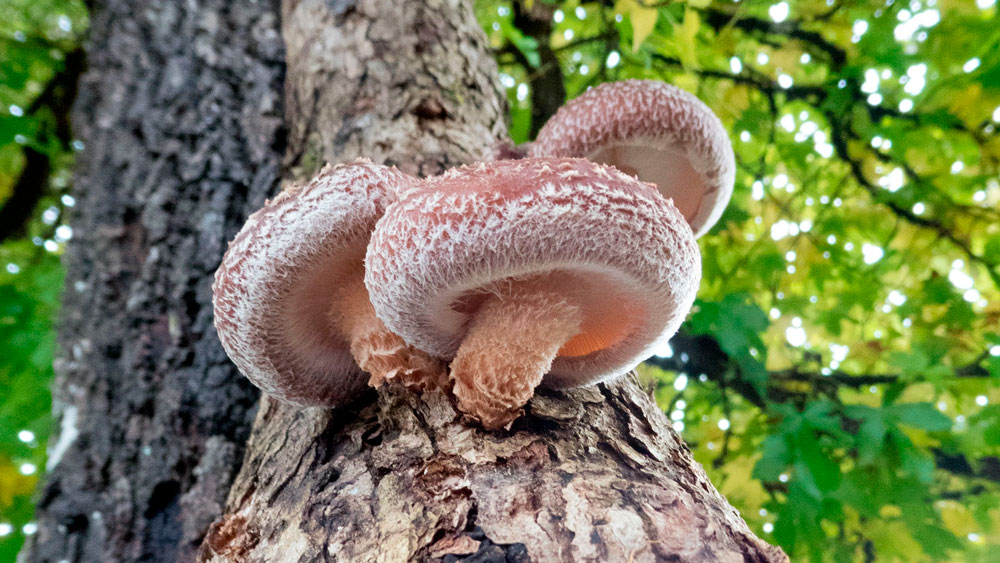
Learn how to grow mushrooms on logs step by step
When autumn comes to an end, the sap that fills the trees begins to descend to the roots to be used during the harshest months of winter. This is the ideal time to cut, fell, or prune the branches or trees that we will use to grow mushrooms on.
Growing mushrooms on logs has become one of the best ways to grow mushrooms at home, simply and effortlessly. We'll tell you all its secrets so you can start growing your own mushrooms on stumps.
What varieties are recommended for growing mushrooms on logs?
Not all edible mushrooms can be grown on logs or stumps. Only certain varieties are suitable for this type of mycological cultivation. The main varieties that can be grown on wood are oyster mushrooms, Pleurotus ostreatus, and its yellow variant, Pleorotus citrinopileatus, and its pink variant, Pleurotus salmoneo stramineus. Shiitake (Lentinus edodes), Poplar mushroom, Reishi, Maitake, etc.
You're probably thinking about that ugly old log you have in your garden or orchard. It's common for trees that we've planted for ornamental purposes to grow too large, leaving us with no choice but to cut them down. With this new way of growing mushrooms, you can give that stump a new lease of life. Not only that, but it will also decorate the space where it stands!
How do cultivated mushrooms feed?
All the species mentioned above have one thing in common: the way they feed. They all grow naturally associated with logs, feeding on their wood or on woody substrates used for this type of cultivation.
What type of log is used to grow mushrooms?
For mycological cultivation on wood, it is recommended to use freshly felled or cut logs. Not only can we give new life to this pruning, but it will also be the ideal medium for growing our own mushrooms.

What type of mycelium should I use?
It doesn't matter if we use cut logs or old stumps that are still buried. What is certain is that the best results are obtained using granulated mycelium.
Another very effective method is to cut slices of the trunk about 3 to 5 cm high and use mycelium from the chosen mushroom to reproduce it. To do this, place the mycelium between the slices and join them together with nails so that the mycelium is in direct contact with the cut wood.
The advantage of this system is that the amount of mycelium that reproduces is much greater than in pellets, but this is only in the early stages of mushroom reproduction, as over time the two systems become equal.
The disadvantage is that a greater quantity of mycelium is used and the trunk degrades more quickly.
What are mycelium pellets?
Granules are pieces of wood, small cylindrical wedges that have been inoculated with the chosen mushroom species. The mycelium gradually colonizes these wood granules until they are ready to be placed in the final log or stump.
These wedges normally have longitudinal grooves so that they fit better when inserted into the hole where they will be placed permanently. This is undoubtedly the best way to start growing mushrooms on logs and is also the most effective way for the mycelium to colonize the wood.
How can I use mycelium pellets to grow mushrooms?
The technique to use is slightly different if we apply the pellets to a cut log than if we do so on a stump.

When is the best time to inoculate the log or stump?
To grow mushrooms on stumps, the best time is between late August and late May, avoiding the hottest months. This is when temperatures are mildest and rainfall is highest, which is what the mushrooms we grow need.
How many pellets will I need?
This is a complicated question because no two logs are the same in diameter or length. As a general rule, you could apply one pellet every 12-14 cm in a staggered pattern, i.e. 2-1-2-1...
This separation will allow the mushrooms to produce and have enough space to develop without getting in each other's way.
How long do the mycelium pellets need to incubate in the log?
We must allow some time for the mycelium to colonize the stump or log. This will take 6 to 8 months under optimal conditions.
During this period, we recommend covering the logs with a tarp or opaque plastic to maintain the correct temperature and humidity.
If we inoculate a stump, we can cover it with soil during this period. To ensure optimal colonization of the mycelium, we will need to remove any shoots or buds that may emerge from the stump itself, as their presence will slow down the development of the fungus.
When will I start harvesting mushrooms from my log?
After these months, mushroom production will begin. However, as mushrooms, their appearance will depend on the temperature and humidity conditions, especially if we are talking about logs located in the ground.
Should I water my mushroom logs or stumps?
Humidity is essential for optimal development. We must keep the logs moist and, in the case of stumps, bear in mind that if we are in a dry season, we must water the soil around the stump so that it absorbs moisture
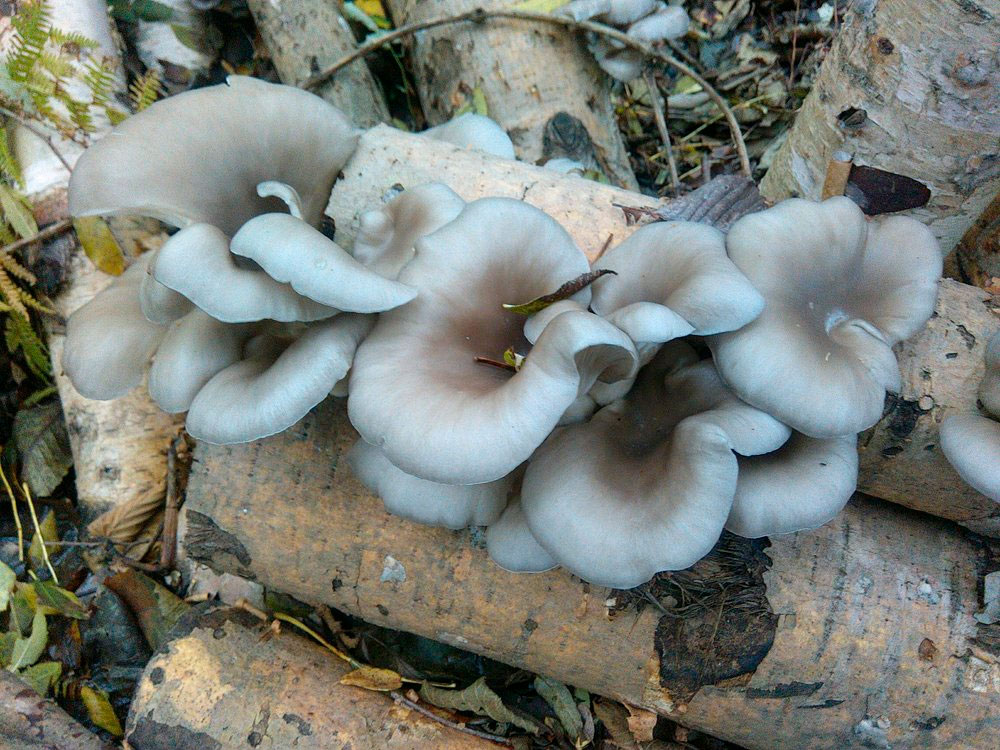
Are mushroom logs attacked by other fungi?
Of course! Like any other. In fact, there are specific fungi for each type of wood. Therefore, if we introduce the appropriate mushroom mycelium pellets, we will promote better, more powerful, and faster development
However, it is possible that other types of mushrooms may appear that are not what we expect. For this reason, using the most suitable mushroom species for each type of wood will give us greater guarantees of success
Is all wood suitable for mushroom cultivation?
Absolutely, there are many different types of wood. Some are soft or very soft, while others are harder than certain metals. There are even woods that float in water! We will need to choose the hardness and type of wood according to the mushroom selected.
The degradation of wood also varies depending on the species used. For example, a soft wood such as poplar degrades in 2 to 3 years, while a harder wood such as oak or holm oak can take between 6 and 7 years.
Which woods are suitable for each species of mushroom?
The following table rates each type of wood on a scale of 0 to 5 (0 = not suitable, 5 = excellent) for use with the selected mushroom.
| Type of wood | Shiitake | Oyster mushroom | Poplar mushroom |
| Poplar (Populus tremula) | 2 | 5 | 5 |
| Álamo (Populus alba) | 2 | 5 | 5 |
| Haya (Fagus sylvatica) | 4 | 2 | 2 |
| Encina (Quercus ilex) | 5 | 1 | 1 |
| Roble (Quercus pubescens) | 5 | 1 | 1 |
| Quejigo (Quercus faginea) | 5 | 1 | 1 |
| Roble albar (Quercus petraea) | 5 | 1 | 1 |
| Arce (Acer nigrum) | 2 | 1 | 2 |
| Pino piñonero (Pinus pinea) | 0 | 0 | 0 |
| Fruit trees | 0 | 0 | 0 |
Inoculating logs for mushroom cultivation
How to inoculate a log with grain mycelium, step by step?
The use of granulated mycelium to grow mushrooms on stumps and logs is very common. The reason for this is its simplicity. Anyone can do it by following these simple steps.
Granulated mycelium is sold in industrial packaging, so with a 3 kg package, we can inoculate 12-15 logs without any problems.
The ideal months for this cultivation are between June and October.
As with any mushroom cultivation, extreme care must be taken with cleaning, as the cultures can be contaminated very easily. We must work with clean, disinfected clothing and it is recommended to spray all utensils and surfaces to be used during the process with alcohol or disinfectant gel. The use of latex gloves is mandatory for this task.
The mycelium must be tempered, so we will leave it at room temperature for 2 hours before use. Please note that any remaining mycelium must be stored in the refrigerator. To do this, consult the manufacturer for the shelf life of the opened mycelium. Ideally, all of the mycelium should be used, so we should not run out of wood.
First, cut the logs into slices between 15 and 30 cm in diameter and between 30 and 50 cm long. You can use a chainsaw, grinder, or hand saw to do this.
We will need a plastic bag or plastic film to cover the trunk once incubation is complete. This will ensure that the mushroom has the right temperature and high humidity
The temperature of the space where we leave the inoculated logs must not fall below 21º, must not receive excessive direct sunlight, and must not be subject to drafts that could dry out the surface of the mushroom. This is extremely important.
The ideal space would be an outdoor area with little light and high humidity.
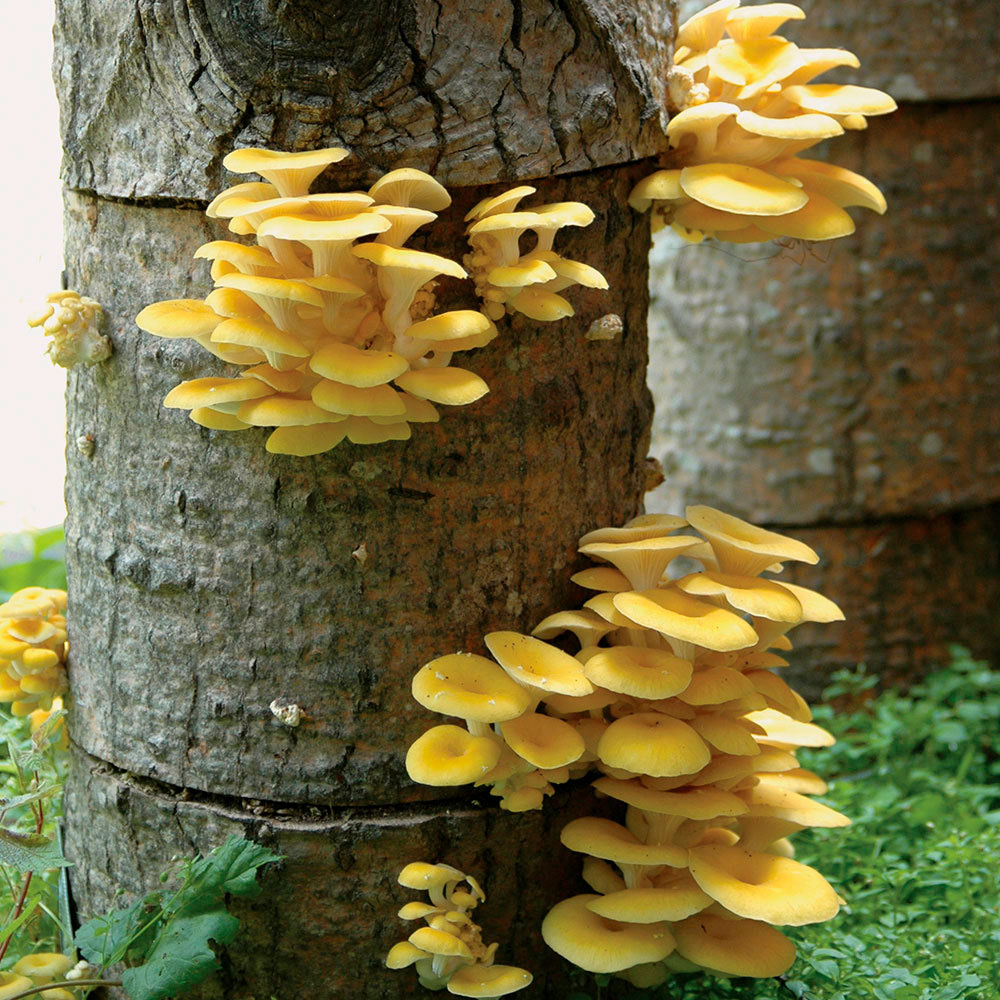
Choosing wood for growing mushrooms on logs
The choice of the best wood will be determined by the species of mushroom to be grown, but in any case, the wood used must be from deciduous species.
It can come from the felling of the main trunk of a tree or from the pruning of its branches, but it must be at least 12-14 cm in diameter.
The wood must be recent, freshly cut, less than 10 weeks old. It must be completely healthy, with no other fungi present, and the bark must be in perfect condition, with no spots that could indicate disease or pathology.
It is recommended to let the wood rest for about 3-4 weeks, never more than 7-8 weeks. This rest period will ensure that any fungicides naturally present in the wood are eliminated
We will organize the inoculation during this period and should not prolong it any further if we do not want to open the door to other contaminating fungi
How to inoculate logs with grain mycelium?
The first step after selecting the logs and letting them rest is to use a chainsaw to cut slices about 30-40 mm thick. It is important that even when cutting the wood, we try to avoid it touching the ground or any type of contaminant that will prevent the natural growth of the fungus.
We will place the mycelium without separation on the cut wood and cover it with the slice of wood that we previously removed from the log. We must secure the slice to the log. To do this, we will use nails, but always taking care not to crush the mycelium too much.
Another technique used on larger logs is not to cut them completely. Simply make cuts at the ends so that they do not need to be joined together with nails.
In any case, once we have placed the mycelium grains in contact with the wood, we will cover them with a strip of paper, such as that used by painters. This will protect the mycelium from contaminants and seal the space.

How long should we incubate the mushroom log?
The time each log will need depends on both the variety of mushroom chosen and the type of wood. As a general rule, it will take between 3 and 6 months for mushroom varieties that grow on soft wood, such as oyster mushrooms or poplar mushrooms.
If we opt for hardwoods, as is the case with Shiitake cultivation, the incubation period can be extended to almost 12 months and rarely less than 6.
Where should I grow mushroom logs?
The location of the log is essential for achieving the desired results. You should choose a warm, dark, and quiet area. An inner courtyard, a storage room, a garage, or even a kitchen would be suitable.
Once you have inoculated the log, you will need to cover it completely with plastic and maintain the temperature between 19 and 21ºC.
To allow the mycelium to breathe, it is advisable to make small holes in the plastic.
If we have followed these steps correctly, the mycelium will begin to conquer the trunk, colonizing it. We will be able to see the hyphae, thin whitish filaments that look like cotton fluff and gradually cover the entire wood of the log, turning it completely white
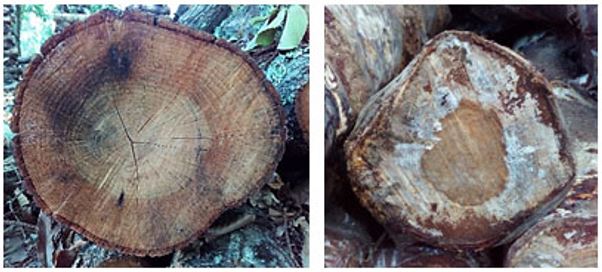
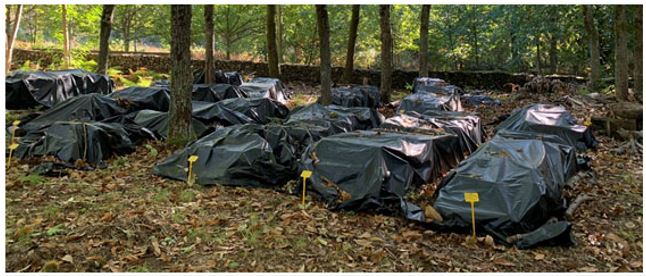
The mycelium has already colonized the trunk, we begin mushroom production
It is time to find the final location for our trunk so that it can begin to produce mushrooms regularly.
To do this, we will look for a shady spot that is protected from drafts and has some humidity.
Once we have found the spot, we will open the plastic covering the log. Once out, we can place the log in several ways.
The one we like best is half-buried in sand or clean peat. About 20-30 cm or enough so that it can stand upright. It would be the same if we buried it in the ground or in a pot.
Another way is to place it upright on a pot without soil or a ceramic plate with water. But be careful, as the trunk may fall over, so it will need to be secured.
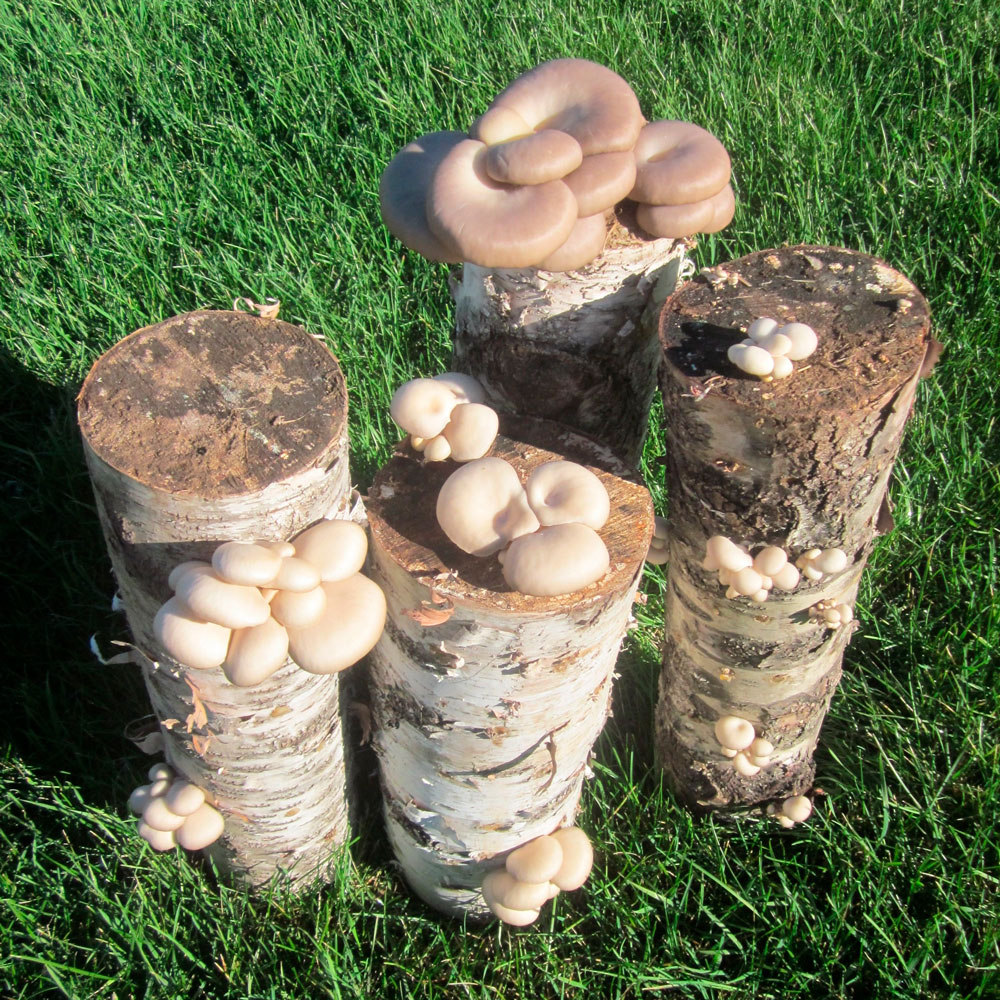
How should I keep my trunk in perfect condition? Should I water it?
Moisture is essential for the growth and development of all mushrooms. This is also true in this case. We must keep the trunk moist at all times. This can be done by watering it regularly, preferably on a gray, cloudy day so that the moisture is better retained. Alternatively, you can water the soil around the trunk.
How much will a mushroom log produce?
Under normal conditions, a mushroom log can produce between 1 and 4 crops per year. To achieve this, the right conditions must be met, including proper humidity, no drafts, and the right temperature.
What is the appropriate size for the logs we will use for cultivation?
The ideal size for a cut log is approximately 75-85 cm in length. This also depends greatly on the diameter of the log.
Once cut, we will use a wire brush to clean the surface, and once this is done, we can start inserting the mycorrhizal pellets. To do this, we can use a drill bit of about 9 mm with which we will make holes spaced about 15 cm apart.
Following this pattern, we will make as many holes as the surface of the trunk allows.
Once the micro pellets have been inserted, we will protect the surface of the trunk with plastic film to prevent contamination and ensure that the humidity remains uniform during incubation.
It is important to leave some areas of the trunk uncovered to allow air to circulate. Once this task is complete, our trunks will be ready to begin the incubation phase.
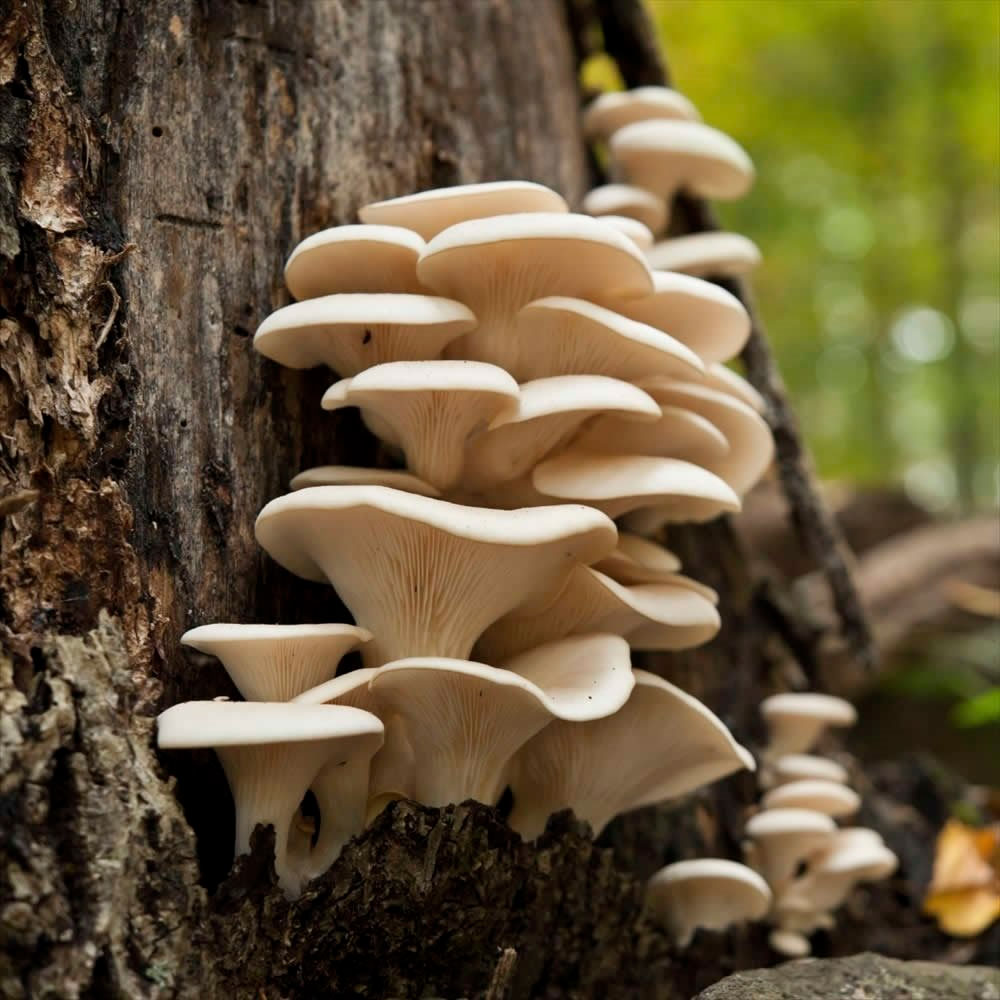
How long does it take for the logs to incubate before they start producing mushrooms?
This phase is the one that will take the longest to complete. Approximately 7-9 months, or even longer. During this period, the logs must remain immobile, in a horizontal position and, if possible, on a mesh or support that helps to separate them from the ground and also provides ventilation. Using a pallet for this task can be a good option.
It is important that during this incubation process, the logs remain in total darkness to prevent mushrooms from appearing too early and thus promote greater development of the mycelium inside the log. The use of opaque black plastic or industrial garbage bags is very common among log mushroom growers. As with plastic wrap, you will need to make several holes to allow air to circulate.
Should I water the logs during incubation?
The answer is YES, especially in summer. The need for watering is less at this time, but you should water the logs at least twice a week. You won't need to use much water; 3 minutes of watering will be more than enough to maintain the necessary humidity.
When can we start producing mushrooms from a log?
Simply observe the area covered by the mycelium. When it has covered the lightest area of the log, the sapwood or young wood closest to the outside, it will be time to start producing mushrooms.
To start production, remove the plastic film and the outer black plastic. The light will then activate the mycelium and the production of the first mushrooms will begin. Of course, as always with mushrooms, you will need to maintain the right humidity and temperature conditions.
Where should I keep the log during production?
Look for a damp, shaded area. This will be the perfect place for the log. It is important that the area is protected from drafts, which are one of the greatest dangers to mushrooms:
Do I need to water the logs during production?
Yes. It is important to maintain the humidity level. Short watering every 3 days will suffice. In addition, we recommend immersing them in water for 18 to 24 hours at least once a month. This will greatly reactivate mushroom production
What if I want to buy a pre-inoculated log to start harvesting mushrooms?
You may not have the time or knowledge to start inoculating logs yourself. If this is the case, don't worry. In our online store, we have mushroom logs inoculated with Shiitake, poplar mushroom, and yellow and white oyster mushrooms.
Our logs, which are 80 to 100 cm tall, are already inoculated and incubated with the selected mushroom.
All you have to do is place them in the chosen location and wait a few days for them to start producing mushrooms. Once the first flush has been achieved, we will leave the log to rest for 3 months and then immerse it in water for 24 hours. By following this process, we will obtain between 3 and 4 flushes per year. And they will continue to do so for 3-4 years!
We also have many other products related to mushroom and truffle cultivation: kits and cultivation alpacas, mycorrhizal trees and plants, mycelium inoculum and all the accessories you need to grow mushrooms at home. Visit our website and become an expert in growing eco-friendly mushrooms on logs.
Health, strains, and mushrooms! !

Te pueden interesar